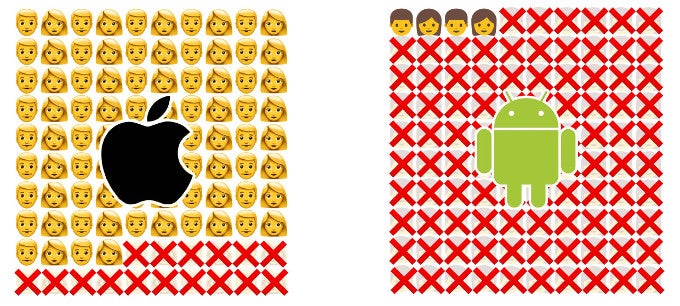Only 4% of Android users can see the newest emoji, but this isn't the real problem

The real problem, and also the reason for the lack of widespread support of newer emoji on Android, is also one of the platform's biggest problems since its inception – software updates. Since emoji are part of the regularly updated Unicode standard, support for them needs to be built at the OS level, making their distribution to older versions cumbersome and, ultimately, not worth developers' time. This is true for both Android and iOS, yet Apple's platform doesn't suffer from the same problem nearly as much. The reason for this is simple – save for the Pixel, Google doesn't build its own phones, and as a result doesn't control the distribution of updates, unlike Apple, their main competitor in this industry, which has exclusive control over its devices' software. This, combined with OEMs' affinity towards OS customization, makes each new Android release painfully slow, as each custom feature needs to be ported, tested, and eventually distributed to users, which is a lengthy and arduous process. And this is the best-case scenario, as more often than not manufacturers simply choose to abandon older devices rather than update them. And, most recently, another big problem was Google's insistence on making Vulkan support mandatory for all Nougat devices, rendering a huge amount of phones “incompatible” with the update.
An easy solution to this problem, however, doesn't exist. Google can't just force OEMs to update, as this would result in one of two things: either the burden of supporting each and every device will fall on Google's shoulders – a task pretty much impossible to handle by a single company, no matter its size; or the responsibility would be that of the vendors, who will quickly find a simpler and cheaper alternative, a number of which have existed through the years, but have ultimately failed precisely because of Android's no-strings-attached policy. The best the company can do right now is lead by example and support their devices like users expect them to. Judging by their track record, however, two years of guaranteed OS updates is the best they can do, and, unfortunately, this has become something of an industry standard. The only major outlier is Apple, with its latest iOS 10 supporting devices all the way back to the iPhone 5, which came out almost five years ago. So while many would disagree with the company's walled garden approach, in this particular case it actually works in users' favor, something more manufacturers should strive for.
source: Emojipedia via Android Central









Things that are NOT allowed: